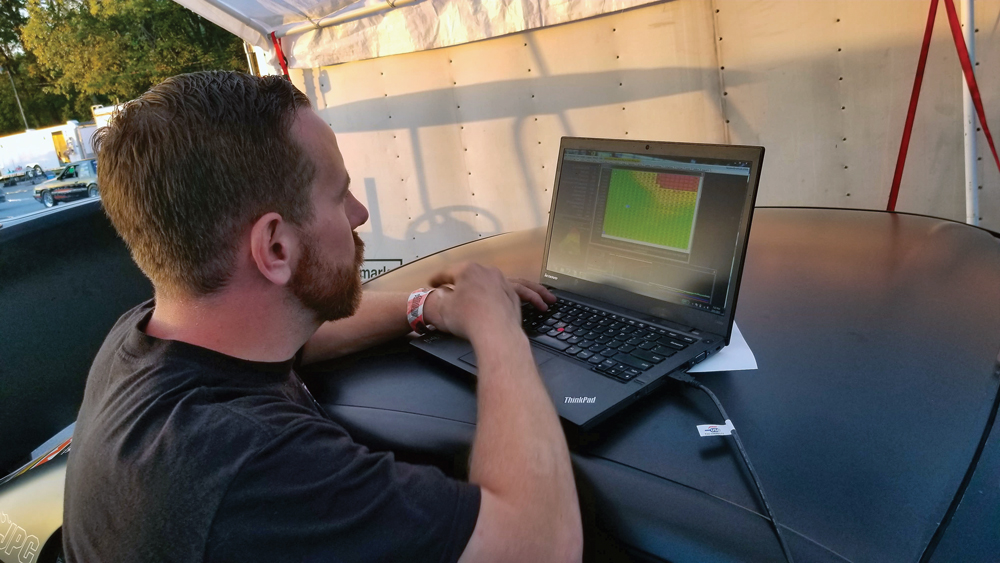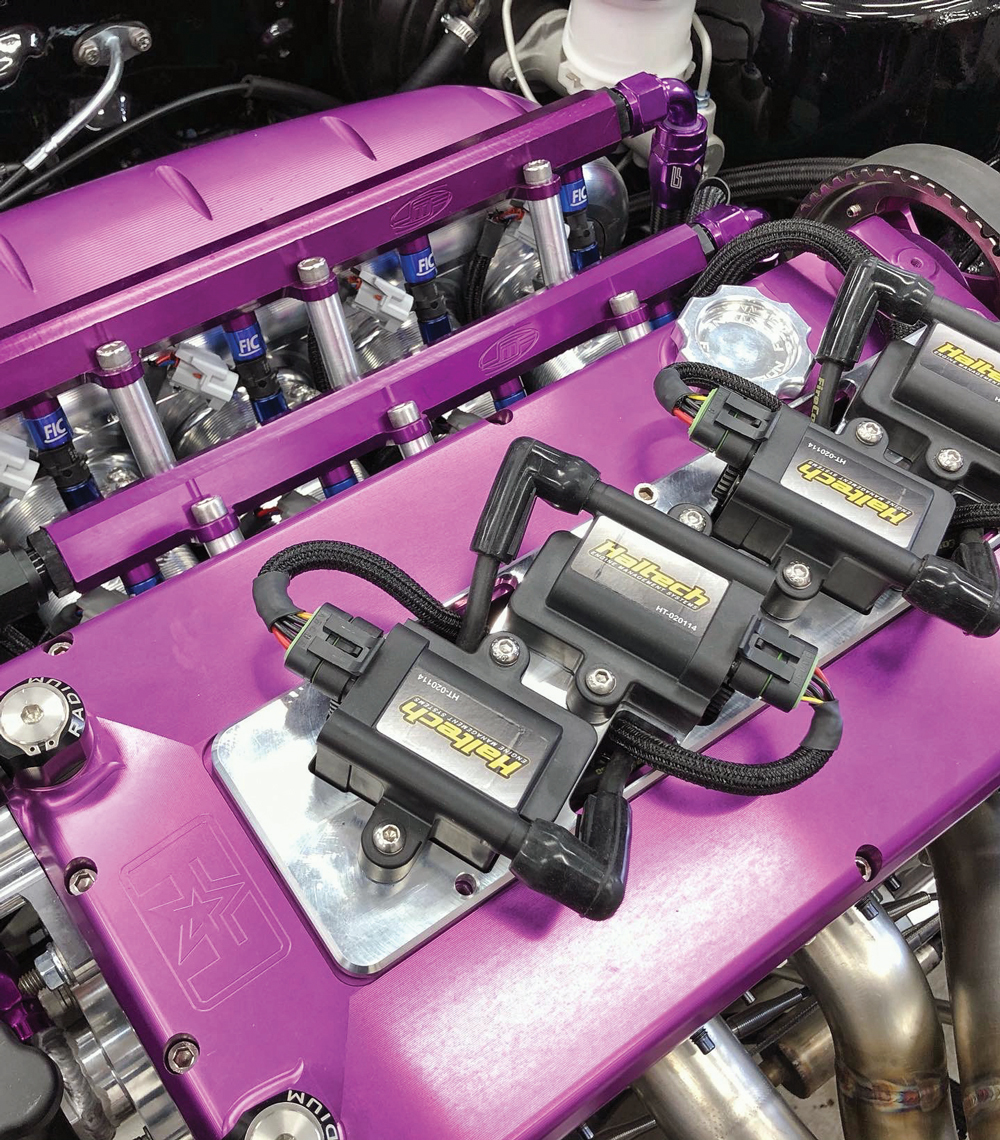FASTER, STRONGER, EASIER: THE EVOLUTION OF EFI

Bolstered by enhanced functionality and more approachable system design, interest in electronic fuel injection systems has never been higher.
There’s an air of artisanship to tuning. Making a race car perform at its best can often be akin to conducting a symphony of different mechanical systems, each affecting one another in different ways that can only be understood and accurately predicted through decades of knowledge and experience.
Carburetion serves as an excellent example of this. In a world of 5G mobility, it’s an analog anachronism that has nonetheless stood the test of time. Some of that can be attributed to the notion that carb tuning expertise can provide a competitive edge under the right circumstances, but at the end of the day, it’s often a case of old habits dying hard.
“I think for a lot of these guys, it comes down to what they know,” said Evan Perkins of Holley Performance Products, Bowling Green, Kentucky. “We still sell a lot of carburetors, and they work great in a lot of applications. So for certain racing classes and teams that have been running a car competitively the same way for a lot of years, they might not see a huge incentive to make a big change like that.”
For decades, the complexity and cost involved in making the switch to a race-ready EFI system damped the appeal even further. But the story has changed in recent years. “These systems are now available in complete plug-and-play kits, and the self-tuning options do so much more than ever before,” said Mark Campbell of Fuel Air Spark Technology (FAST), Memphis, Tennessee. “They’re designed to be user friendly, and more of a direct bolt-on upgrade.”
And for those that are considering making the switch, the tuning and control benefits of electronic fuel injection typically drive their interest, but it’s the approachability of these systems that will ultimately determine which side of the fence they land on.

Breaking Down Barriers
One of the major roadblocks that hampered widespread adoption of EFI for some time was the lack of available options. Like carburetors, EFI is not a one-size-fits-all type of endeavor, and the prospect of taking on the cost and complexity of a system that wasn’t designed to work in a particular application relegated race-ready, high-horsepower EFI systems to more niche-use cases. However, many aftermarket companies have made significant strides in this area and now offer an array of different products that range from affordable, all-in-one carburetor replacement throttle body systems, to sportsman-level solutions with enhanced feature sets and customization options, to hardcore, purpose-built motorsports systems with advanced fueling, tuning, and sensor reading capability.
“I would say on the entry-level end, the leading driver of this trend is the refinement and expansion of the self-learning systems that provide accessibility to the core benefits of EFI, including easier, cleaner cold start, better throttle response, and better air/fuel ratios across the engine’s operating range, all of which are now obtainable with minimal EFI tuning knowledge required,” said Brett Clow of Aeromotive, Lenexa, Kansas. “On the other end of the spectrum, we also have significant advancements in injector flow rates and improvements in ECU programmability, the latter of which allows for things like per-cylinder tuning and fail-safe ignition features to deliver the highest possible power with the safest spark and fuel control.”
Tim Jilg of Fuel Injector Clinic in Hobe Sound, Florida, pointed out that for many younger racers who are bringing aftermarket fuel injection into their programs, EFI is where they started. “One of the biggest markets right now for engine platforms across a number of different racing disciplines is the LS. Fuel injection has always been part of that platform, so the folks who’re tuning these engines are familiar with the technology and benefits that EFI offers even before they make that upgrade.”
Data logging has also become something of a gateway drug for many of the carbureted holdouts. “It’s a trend we’ve seen in sportsman-level drag racing in particular; high-horsepower, steel-bodied cars with power adders,” said Lawson Mollica of AEM Performance Electronics, Hawthorne, California. “When we first engaged with these guys a few years ago, a lot of them were running carburetors, and they didn’t come to us looking for EFI—they were looking for data acquisition.
“At that point it wasn’t that they lacked the capability to tune on EFI, they simply didn’t have the familiarity,” he continued. “And as these guys have acclimated into the world of data acquisition with a handful of channels that have helped them make improvements pass after pass, they’re not only getting used to the software interface, they’re also seeing where carburetion is limiting what they can do and how integrated their overall setup can be.”
Holistic Hardware
In an effort to eliminate guesswork and reduce the number of steps required to get the system up and running, many EFI manufacturers now offer comprehensive packages that include all of the components needed to make that system operational under a single part number.
“These kits can be bought with the entire fuel system, wiring harness, and all the sensors for a simple plug-and-play install,” Campbell said. “FAST even offers simplified fuel systems with our universal EFI sump fuel kits, which feed off of a stock-style mechanical fuel pump and have an internal high-pressure pump that can supply the right pressure and volume for an EFI system to run.”

The designs of the EFI systems themselves have become easier to work with as well, both from a packaging standpoint as well as their aesthetics. “Our Sniper products are considered carburetor replacement systems in that they contain the ECU, the required sensors, and the injectors within one device,” Perkins explained. “And we offer these in different carburetor patterns, so a guy who has an Autolite 1100, for instance, can get a Sniper system that not only bolts to the original manifold and works with the existing air cleaner, it also looks like the carburetor it’s replacing and occupies about the same amount of space in the engine bay.”
These simplified and application-specific designs have made EFI conversions more compatible with existing hardware and potentially less costly to do, in turn broadening its appeal to a wider audience of racers. “The fact that these throttle body EFI systems offer self-contained fuel injectors and throttle linkage that can support installation directly onto the existing carbureted intake manifold and connect to existing throttle linkages makes this a minimally invasive upgrade,” said Clow.
Software Refinements
Still, the biggest hurdle facing many would-be EFI converts in the motorsports world isn’t the installation of the new hardware, it’s the perceived learning curve of the software. Fortunately, it’s an issue that EFI manufacturers appear to be keenly aware of.
“There are some systems where it seems like it takes a computer programmer to tune them, but that is not our goal,” said Perkins. “A lot of it really just comes down to the vernacular. So for us, it’s about making sure that the terms we’re using in the software are going to be things they’re familiar with.”
It’s also important to note that the self-tuning functions in the latest batch of EFI systems is impressive tech in and of itself, not only because it can quickly and effectively dial in the system on its own, but because it can start to do so with minimal input from the user if need be. “With the advancements in self-learning software, combined with increasingly effective built-in tuning databases, we find these systems are working better and better across a broader range of engine combinations,” said Clow. “And with a growing database of engine combinations to draw baseline tunes from, the transition is just getting easier and more attractive to do.”
Jens von Holten of Fuel Injector Clinic cited a two-step process that he sees as an effective strategy to make the switch to EFI both approachable and ultimately highly effective. “The first step would be to get a self-learning carburetor replacement system, which have some adjustability but are more or less designed to do what they do right out of the box,” he explained. “And then from learning that whole process and looking at the data, once you’re comfortable with adjustability that no longer comes from replacing a jet or turning a screw, you could be ready to move up to a more sophisticated system to really gain all the benefits that EFI has to offer.”
But that isn’t to say there aren’t options for the guys who’re ready to go a bit deeper from the outset. “One of the ways we do that is by providing setup wizards for the various features within our systems,” Mollica said. “The software is going to ask you things like what your cam and crank timing pattern is, what your firing order is, and so on, and once you’ve answered this basic information, you can go to your volumetric efficiency table and put in a baseline number across the entire VE table, turn the key, and the engine is going to turn over and run. Now you’ve got your starting point for dyno tuning.”
Perkins also noted that there are ways to make these systems both approachable and sophisticated through the design of the user interface. “Most racers are not going to leave a self-tuning strategy alone—eventually they’re going to want to get in there and finesse the tune to find every bit of horsepower that’s available, and so there are basically layers of capability within the software,” he said. “All of the layers are there, but an entry-level tuner doesn’t need to dig quite as deep as a professional tuner does to get to the menus that are relevant to them.”
And bridging the gap between accessibility and competition-level capability will only take on greater importance as EFI adoption continues to spread throughout motorsports. “Horsepower levels are soaring across all types of fuel, with EFI engines now producing 5,000-plus flywheel horsepower in some cases, and many engine combinations are now capable of delivering streetable manners in the 1,500 to 2,500 rear-wheel horsepower range,” said Clow. “And with the ever-increasing sophistication in engine fuel management provided by modern EFI systems, this horsepower envelope is continually being pushed higher. Part of that is due to our increasingly detailed, empirical knowledge of engine function regarding air and fuel flow behaviors, and their real-time interaction in the intake manifold and combustion chamber. As this level of knowledge and understanding grows, we see the level of ECU sophistication improving alongside it.”
Enhancing the ease of use of these systems while also providing the technical depth that will allow racers to extract every ounce of performance from their engine combinations could prove to be a tough balancing act going forward, but it’s a challenge that EFI manufacturers are confronting head-on. “It goes back to that layering concept—for instance, our version 6 EFI software has transmission dump valve control, torque converter lockup control, and a number of other features that the grassroots guy might never need to touch,” said Perkins. “But it’s there for the professional tuner and racer if they need it.”
SOURCES
–
AEM Performance Electronics
aemelectronics.com
Aeromotive
aeromotiveinc.com
EFILive
efilive.com
FAST (Fuel Air Spark Technology)
fuelairspark.com
Fuel Injector Clinic
fuelinjectorclinic.com
Holley Performance Products
holley.com
 MEMBERSHIP LOGIN
MEMBERSHIP LOGIN JOIN PRI
JOIN PRI


